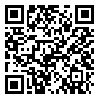Fri, Jul 4, 2025
[Archive]
Volume 1, Issue 1 (January 2005)
IJEEE 2005, 1(1): 18-27 |
Back to browse issues page
Download citation:
BibTeX | RIS | EndNote | Medlars | ProCite | Reference Manager | RefWorks
Send citation to:



BibTeX | RIS | EndNote | Medlars | ProCite | Reference Manager | RefWorks
Send citation to:
Implementation of an adaptive burst DQPSK receiver over shallow water acoustic channel. IJEEE 2005; 1 (1) :18-27
URL: http://ijeee.iust.ac.ir/article-1-40-en.html
URL: http://ijeee.iust.ac.ir/article-1-40-en.html
Abstract: (50522 Views)
In an environment such as underwater channel where placing test equipments are
difficult to handle, it is much practical to have hardware simulators to examine suitably
designed transceivers (transmitter/receiver). The simulators of this kind will then allow
researchers to observe their intentions and carry out repetitive tests to find suitable digital
coding/decoding algorithms.
In this paper, a simplified shallow water digital data transmission system is first introduced.
The transmission channel considered here is a stochastic DSP hardware model in which
signal degradations leads to a severe distortion in phase and amplitude (fades) across the
bandwidth of the received signal. A computer base-band channel model with frequency
non-selective feature is derived by the authors [10-11]. This system was based on fullraised
cosine channel modelling and proved to be the most suitable for vertical and shortrange
underwater communication csdfher), with a reflected path (specula component, when
the acoustic hydrophone receives reflected signals from surface and bottom of the sea) and
a random path (diffused component, when the acoustic hydrophone receives scattered
signals from the volume of the sea). The model assumed perfect transmitter-receiver
synchronization but utilized realistic channel time delays, and demonstrated the timevarying
characteristics of an underwater acoustic channel observed in practice. In this
paper, they are used to provide a full system simulation in order to design an adaptive
receiver employing the most advanced digital signal processing techniques in hardware to
predict realizable error performances.
Keywords: Underwater Channel Modelling , Adaptive Receivers , Hardware Digital Signal Processing , Advanced Detection and Estimation Schemes
Type of Study: Research Paper |
Received: 2008/10/12 | Revised: 2011/06/13 | Accepted: 2011/06/13
Received: 2008/10/12 | Revised: 2011/06/13 | Accepted: 2011/06/13
| Rights and permissions | |
 |
This work is licensed under a Creative Commons Attribution-NonCommercial 4.0 International License. |





